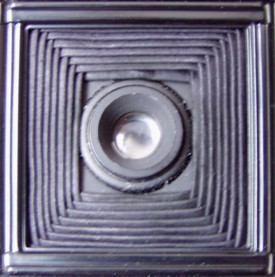Difference between revisions of "Bellows"
| Line 8: | Line 8: | ||
{| | {| | ||
|- | |- | ||
| − | ||[http://www.flickr.com/photos/rebollo_fr/342695518/in/pool-camerapedia/ http://farm1.static.flickr.com/128/342695518_5f72eeb4c5_m.jpg] | + | ||[http://www.flickr.com/photos/rebollo_fr/342695518/in/pool-camerapedia/ http://farm1.static.flickr.com/128/342695518_5f72eeb4c5_m.jpg] |
| − | ||[http://www.flickr.com/photos/rebollo_fr/342689711/in/pool-camerapedia/ http://farm1.static.flickr.com/124/342689711_e44bc8378d_m.jpg] | + | ||[http://www.flickr.com/photos/rebollo_fr/342689711/in/pool-camerapedia/ http://farm1.static.flickr.com/124/342689711_e44bc8378d_m.jpg] |
| + | |- | ||
| + | |colspan="2"|The average folding camera unfolds its bellows to a fixed length. Some models with exchangeable lens allow different bellows expansion lengths. Some sophisticated amateur cameras allow tilts and shifts. But in most amateur cameras the bellows is just optimized for the compactness of the folded camera. | ||
|} | |} | ||
</div> | </div> | ||
| Line 19: | Line 21: | ||
||[http://www.flickr.com/photos/twin_lens/271286812/ http://farm1.static.flickr.com/119/271286812_ae791b4e20_m.jpg] | ||[http://www.flickr.com/photos/twin_lens/271286812/ http://farm1.static.flickr.com/119/271286812_ae791b4e20_m.jpg] | ||
|- | |- | ||
| − | |colspan="2"|Bellows for macro photography with modern SLRs are geometrically more like accordion bellows than like typical built-in camera bellows. That means a macro bellows has an equal diameter throughout its length. The bellows of professional view cameras are as well accordion-like or with | + | |colspan="2"|Bellows for macro photography with modern SLRs are geometrically more like accordion bellows than like typical built-in camera bellows. That means a macro bellows has an equal diameter throughout its length. |
| + | |||
| + | The bellows of professional view cameras are as well accordion-bellows-like or with only little reduction of diameter towards the lens mount plate. That gives these bellows better flexibility for tilting and shifting the lens to reach optimal image geometry and sharpness plane. | ||
|} | |} | ||
</div> | </div> | ||
Revision as of 19:45, 18 February 2007
A bellows can be integral or optional part of a photographic camera and serves as alternate lens tube or lens tube extension. For photographing a bellows has to be expanded to its working length. Most bellows cameras have a front door upon which the bellows unfolds when the door's opened for camera usage. More sophisticated bellows cameras allow to fix the bellows in various positions to optimize the image plane for special applications like architecture photography.
As optional part of a camera for exchangeable lenses a bellows extends the lenses' capablities to make images of small objects in small distance by extending the lens tube's length. Therefore such a bellows can be fixed in as many lengthes as the maximal length of its guide rail(s) allow.




